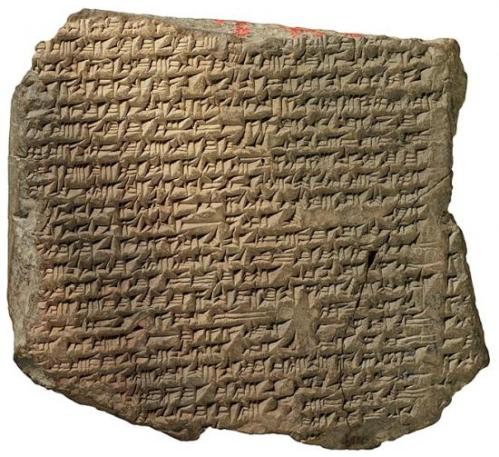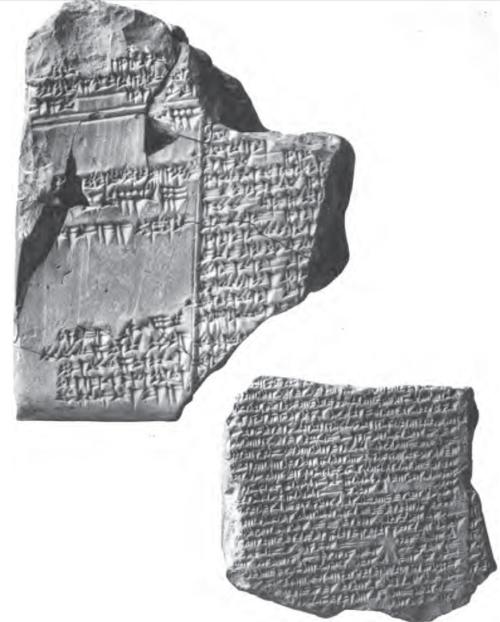Izre’el: Adapa and the South Wind as Mythos
“A Sumerian version of Adapa from the Old Babylonian period has been discovered at Tell Haddad (ancient Meturan) and has been announced by Cavigneaux and al-Rawi (1993: 92-3). The Sumerian version is reported to be similar to the Akkadian version. It includes “an incantation-like passage” at the end, as does the Akkadian version represented by Fragment D.
Furthermore, the myth is the second part of a longer narrative, the first part of which describes the time just following the deluge and describes the feeding of the gods and the organization of mankind.
The discovery of the myth of Adapa and the South Wind immediately attracted wide attention. Its ideology and its correspondence to the intellectual heritage of Western religions precipitated flourishing studies of this myth, both philological and substantive.

This is MLC 1296, an Akkadian fragment of the Adapa Myth in the collection of the Morgan Library and Museum.
http://corsair.themorgan.org/cgi-bin/Pwebrecon.cgi?BBID=215815
Many translations have appeared during the past century, shedding light on various aspects of the myth and its characters. Picchioni (1981) made use of the scholarly work that preceded him, but following his monograph further studies and new translations of the Adapa narrative appeared (among which were Michalowski 1980; Müller 1983-4; Dalley 1989; Talon 1990; Dietrich 1991; Izre’el 1991a; Müller 1991; Dietrich 1993; Foster 1993; Izre’el 1993: 52-7; 1997: 43-50; Kämerer 1998: 254-59).
Picchioni’s monograph marked a turning point in the Assyriological study of the myth and became the standard edition of the myth. There are several reasons for this: first, it summarized the diverging views published in the secondary literature.
Second, Picchioni’s critical edition was solid and up to date. Third, his study established (although not without precedent; see Böhl 1953: 149-50; 1959; Hecker 1974: in passing, index: p. 214; cf. already Zimmern in Gunkel 1895: 420-1 n. 2) that the structure of the text (more specifically, the Amarna fragment) must be viewed as verse.
This enhanced our understanding of the text as a piece of literature (cf. von Soden 1984: 227-30; Izre’el 1991a).
However, in spite of comprehensive treatment of the personae and symbols of the myth, Picchioni’s treatment of the narrative itself was remarkably brief (cf. Ella 1983). It is precisely with this in mind that I am publishing the present study: I am unveiling the myth of Adapa and the South Wind as mythos, as story. To do this, I will analyze the underlying concepts through extensive treatment of form.
First I offer an edition of the extant fragments of the myth, including the transliterated Akkadian text, a translation, and a philological commentary. As the reader will see, I consider language the salient and crucial part of any textual treatment, especially one that analyzes the overt and covert meanings of a myth.

These cuneiform originals are from Albert T. Clay, A Hebrew Deluge Story in Cuneiform. New Haven: Yale University Press, 1922.
This particular photograph states, “Early Atrahasis Cuneiform Original –Reverse
Adapa Version – Obverse (Reverse is destroyed).”
http://www.cumorah.com/index.php?target=view_other_articles&story_id=59&cat_id=7
I cannot overemphasize the need for thorough philological and linguistic analysis before discussing meaning, even though some interpretations are merely the result of context-realizations.
The analysis of poetic form that follows will then lead to analyzing the myth as a piece of literature and to uncovering its meaning—or rather, meanings.
This study therefore marks another phase in the long, extensive, and never-ceasing research into this abysmal Mesopotamian myth. Being just one of many human beings allured to and intrigued by this tale told in ancient times to a more understanding audience than ours, I wish to share with my own audience both my interpretation and my impression of this particular myth, as well as the methodology that I have adopted for my enquiry.
Within these confines, I hope that this study will have something to offer to the more general study of the Mesopotamian, especially the Akkadian, mythological texts.”
Schlomo Izre’el, Adapa and the South Wind: Language Has the Power of Life and Death, Eisenbrauns, 2001, pp. 7-8.


